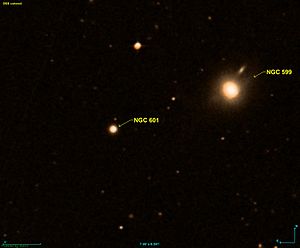NGC 601
| Galaxy NGC 601 |
|
|---|---|

|
|
| AladinLite | |
| Constellation | whale |
|
Position equinox : J2000.0 , epoch : J2000.0 |
|
| Right ascension | 01 h 33 m 06.6 s |
| declination | -12 ° 12 ′ 31 ″ |
| Appearance | |
| Morphological type | Compact |
| Brightness (visual) | 15.1 mag |
| Brightness (B-band) | 16.1 mag |
| Angular expansion | 0.4 ′ × 0.4 ′ |
| Surface brightness | 13 mag / arcmin² |
| Physical data | |
| Redshift | 0.018700 |
| Radial velocity | 5606 km / s |
|
Stroke distance v rad / H 0 |
(251 ± 18) x 10 6 ly (77.0 ± 5.4) Mpc |
| history | |
| discovery | Frank Muller |
| Discovery date | 1886 |
| Catalog names | |
| NGC 601 • PGC 73980 • 2MASX J01330657-1212317 • Mrk 1000 • NPM1G -12.0067 • GALEX ASC J013306.58-121232.1 | |
NGC 601 is a compact galaxy of Hubble type C in the constellation Cetus south of the celestial equator . It is an estimated 251 million light years from the Milky Way and about 30,000 light years across.
In the same area of the sky are u. a. the galaxies NGC 589 , NGC 593 , NGC 599 , IC 128 .
The object was discovered in 1886 by the American astronomer Frank Muller .
Web links
- SIMBAD Astronomical Database
- Auke Slotegraaf : NGC 601. Deep Sky Observer's Companion, accessed on August 26, 2015 .
